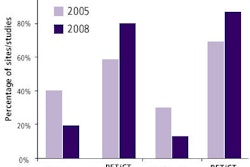FDG-PET imaging can be helpful in determining how atherosclerotic plaque inflammation relates to calcification and vascular risk factors, and the technique also may be used to identify atherosclerotic disease activity.
The findings come from a new study at the Mount Sinai School of Medicine in New York City that examined how arterial inflammation measured by PET correlates with plaque inflammation and the presence of risk factors for vascular disease. Co-authored by Dr. James H. F. Rudd and Kelly S. Myers, the study was published online on January 26 in the journal Circulation from the American Heart Association (AHA).
Researchers prospectively recruited 41 patients from Mount Sinai's cardiac catheterization lab and vascular outpatient clinics. All patients had previous myocardial infarction, stroke, or peripheral vascular disease, or at least three cardiovascular risk factors.
Data were gathered about the patients' age, gender, ethnicity, and history of coronary artery disease, cerebrovascular disease, and cigarette smoking, as well as diagnosis of or treatment for hypertension. Also catalogued were history of diabetes, family history of heart disease, body mass index, and medication use.
Scan protocol
All patients initially received a body scan of the aorta, iliac, and femoral arteries 90 minutes after FDG injection in 2D mode, with 10-minute acquisitions at each bed position. Patients also underwent a PET/CT scan (LightSpeed, GE Healthcare, Chalfont St. Giles, U.K.) after a minimum six hours of fasting and injection of 370 MBq of FDG.
Of the enrolled patients, 40 underwent carotid imaging, 27 received aortic imaging, 24 were taken for iliac imaging, and 13 underwent femoral imaging.
CT was used for attenuation correction, anatomical coregistration, and quantification of arterial calcification. No CT contrast agent was administered. The researchers measured FDG uptake by drawing regions of interest around the artery on each slice of the transaxial coregistered PET/CT images.
Arterial images
In the analysis, PET/CT images showed the carotid and all regions of the aorta as more inflamed than the peripheral arteries, and the degree of FDG uptake across different arterial territories was more prominent between adjacent territories, such as neighboring aortic regions, carotid artery, and aorta, than between more distant regions, as was seen in a comparison of the carotid and femoral arteries.
In addition, arterial FDG uptake and calcification were uncommon in the same artery. "In those arteries in which both calcium scoring and FDG imaging [were] performed, there were negative correlations noted between inflammation and calcification," the researchers wrote. "A similar finding was noted in the ascending aorta but this did not reach statistical significance."
In the 40 patients who received carotid artery scans, FDG uptake was significantly greater in males than females. Arterial FDG uptake also was significantly greater in patients with a prior history of coronary artery disease.
Other factors in the study such as age, diabetes, hypertension, the use of statin medication, or ethnicity did not significantly affect FDG uptake in any arterial region.
FDG uptake and biomarkers
In addition, the researchers noted that patients with the highest levels of FDG uptake also had the greatest concentrations of inflammatory biomarkers, while there were no significant trends seen between FDG uptake and levels of interleukin 18, fibrinogen, and C-reactive protein.
The results, the researchers wrote, demonstrate "that arterial FDG-PET imaging can provide new insights into the pathobiology of atherosclerosis." They also recommended that future studies "might test an arterial inflammation score derived from FDG-PET and circulating biomarkers as a means of predicting clinical events in high-risk individuals. However, large, prospective event-driven studies of noninvasive inflammation imaging techniques are the best way to determine the place of these modalities in future clinical practice."
Those studies currently are under way and are due for completion in 2011.
By Wayne Forrest
AuntMinnie.com staff writer
February 23, 2009
Related Reading
MRI beats PET for myocardial evaluation in patients with impaired LV function, January 9, 2009
FDG-PET/CT may play role in plaque evaluation, September 12, 2008
Cedars-Sinai explores PET's future in nuclear cardiology, April 11, 2008
Coronary CTA's time is now, according to Dowe, January 17, 2008
New PET tracer may improve atherosclerotic imaging, November 15, 2007
Copyright © 2009 AuntMinnie.com




















